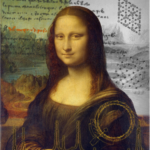BAGs supporting the research on Da Vinci’s painting methods
Researchers from the laboratory Photophysique et photochimie supramoléculaires et macromoléculaires (CNRS/ENS Paris-Saclay), the Institut de recherche de chimie Paris (CNRS/Chimie ParisTech – PSL), the Centre de recherche et de restauration des musées de France (Ministère de la culture), the Louvre Museum, the Laboratoire d’archéologie moléculaire et structurale (CNRS/Sorbonne Université) and the ESRF, the European Synchrotron, have studied a microsample of the preparation layer of the Mona Lisa to shed light on Da Vinci’s painting methods. To get more clues about Da Vinci’s palette and technique, they also analysed several fragments from the Last Supper, another masterpiece by Leonardo.

“In Mona Lisa, we found a relatively high amount of plumbonacrite, an unusual compound that we think is due to a specific mix of oil with lead oxide”, explains Victor Gonzalez, a researcher at the laboratory Photophysique et photochimie supramoléculaires et macromoléculaires (CNRS/ENS Paris-Saclay) and corresponding author of the publication. However, the team had seen this component before, specifically in Rembrandt’s masterpiece The Night Watch, painted two centuries after the Mona Lisa. This enabled the scientists to identify possible hypothesis to explain its presence despite the chronological differences between the two artists.
The team used the techniques of synchrotron radiation high-angular resolution X-ray powder diffraction (SR-HR-XRPD), micro X-ray diffraction (µXRD) and micro Fourier-transform infrared spectroscopy (μ-FTIR) at the ESRF’s ID22, ID13 and ID21 beamlines, respectively. The results show the presence of a very uncommon composition in the Mona Lisa’s ground layer and the Last Supper’s ground and paint layers.
“We faced the additional challenge that there is very little scientific analysis of Mona Lisa and of Da Vinci’s paintings in general, so it was difficult to compare our results with previous studies”, explains Marine Cotte, scientist at the ESRF and co-author of the publication.
“With this study, we provide key elements to understand Da Vinci’s recipes and the evolution of his paintings throughout time”, says Gonzalez. “The research results show that he experimented with preparing thick and opaque ground layers”, he concludes.
This research has benefited from the Cultural Heritage Block Allocation Group (BAG), a new access mode at the ESRF enabled by the STREAMLINE project, that allows the cultural heritage community to get group access to beamtime on a regular basis, meaning that several experiments can take place in a single session.
Reference: Gonzalez, V., et al, JACS, 11 October 2023. https://doi.org/10.1021/jacs.3c07000
Image: Artistic impression of the Mona Lisa. Credits: I. Fazlic, M. Cotte & V. Gonzalez.